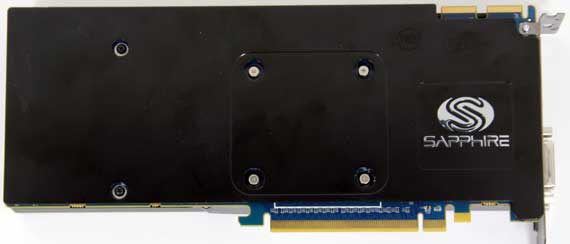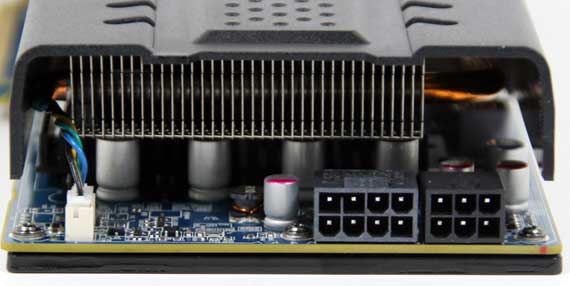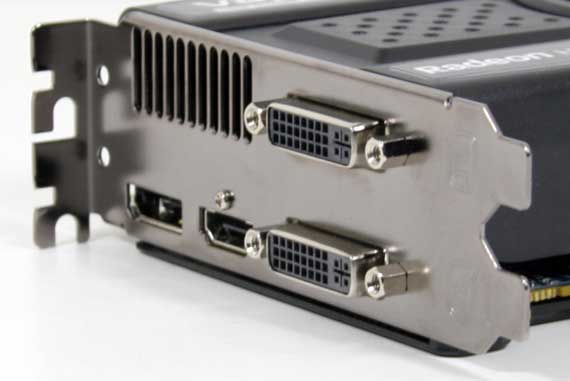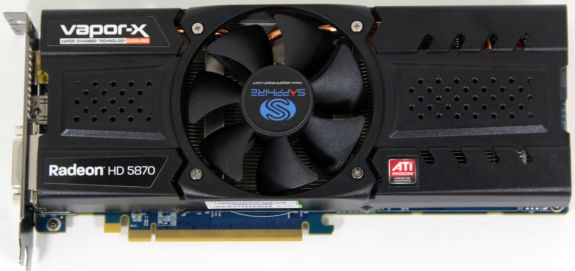Overclocked: Our Custom Radeon HD 5870 Roundup
by Ryan Smith on May 19, 2010 11:53 AM ESTSapphire Radeon HD 5870 Toxic 2GB
We’ll start things off with Sapphire’s Radeon HD 5870 Toxic. The 5870 Toxic 2GB is Sapphire’s shot at a custom 2GB Radeon HD 5870, forgoing AMD’s 5870E6 design for a design of their own. In this case Sapphire has ditched the Eyefinity 6 concept entirely, opting to build a card closer to a regular 5870 with 2GB of RAM. The result is a card that’s best described as a 2GB 5870, rather than a 5870E6.
The Toxic gets Sapphire’s customary touch, equipping the card with one of their famous Vapor-X coolers, the cornerstone of which is the use of a vapor chamber in the cooling assembly’s baseplate. The entire assembly is a card-sized aluminum heatsink connected to the baseplate by 3 heatpipes, with a 92mm fan in the center. Meanwhile the back of the card has a plate on it to serve double-duty as both a decoration and as a heatsink for the 8 128MB GDDR5 RAM modules on the back of the PCB. As with their other Vapor-X cooler products, the Vapor-X cooler on the Toxic is a partially covered design that blows air towards both the front and the rear of the card, so you’ll need a well-ventilated case for this card.

Moving on to the PCB, as with everything else this is a custom Sapphire design, a new design necessary to fit the extra 1GB of RAM. The card is 10.15” in length, making it shorter than the reference 5870. Unfortunately Sapphire also kept up their tradition of putting the PCIe power sockets on the rear of the card instead of the top, so it’s really 10.15” plus whatever room you need to maneuver your power cords. Speaking of which, since this is a 2GB 5870, the 5870 Toxic 2GB requires both 8pin and 6pin PCIe power to operate.

For component selection, Sapphire has decided to focus on their use of chokes and capacitors. Once again we see Sapphire’s grooved “Black Diamond” solid state chokes, and all of their capacitors are solid capacitors. As is the case with the rest of the cards in this roundup, this is as much a technical matter as it is a marketing matter: the reference 5870 design already uses solid state chokes and solid capacitors. So the difference comes down to component selection, with Sapphire using their higher quality chokes.
Sapphire is once again targeting the factory overclock market with the Toxic, shipping the card with a core clock of 925MHz and a memory clock of 1.225GHz (4.9GHz effective) – 75MHz and 100MHz faster than the stock 5870’s core and memory respectively. Since Sapphire isn’t targeting overclockers with this card it should come as no surprise that there’s little in the way of overclocking features for it. There is a generous overdrive limit of 1000/1500 for the card, but as it’s using Sapphire’s unprogrammable VRMs, there’s no way to change the GPU voltage. Making up for that is the card’s slightly higher default core voltage of 1.2v, necessary to drive the card’s higher core clock.

The included materials are also sparse: drivers, AnySim HD, power adapters, a VGA dongle, a CF bridge, and a generic multilingual manual.
Since this is not an Eyefinity 6 edition card, the port configuration is AMD’s standard Eyefinity configuration: 2xDVI, 1x DP, and 1x HDMI. The 2GB of RAM should also be of some help when it comes to Eyefinity, however as we saw in our 5870E6 review it’s limited at best.

The retail price of the card is around $500 – we briefly saw it at $489 before it went out of stock. Compared to the other cards in this roundup, the Toxic is going to be the hardest to find, as it’s currently out of stock everywhere we’ve checked. When in stock however, it’s priced close enough to the 5870E6 that they’re substitute products, so if you’re willing to give up 3 mini-DisplayPorts, you can get a factory overclocked 5870 instead.











43 Comments
View All Comments
Jediron - Saturday, May 22, 2010 - link
These are not cards for a gamer, but for people who make it a sport to beat the other guys 3Dmark results.Gamers, you'll see it hardly makes a difference, gameexperience is something else then raw, digital FPS numbers. Save yourself alot of cash and buy a default clocked card; that leaves you with enough money to buy your favorite game ;)
cauchy2k - Thursday, May 20, 2010 - link
People should not take into account this near 100 °C ,becuase you can increase fan speeds and lower temps a lot.hglazm - Thursday, May 20, 2010 - link
Either you got a bad chip with the lightning, got an exceptional chip with the Toxic, or did something wrong when overclocking the lightningBecause both of mine hit 1ghz without issue. As well as three of the four 5770 HAWKs my friends have ordered (one hit 980 instead of 1020-1060).
Ninjahedge - Thursday, May 20, 2010 - link
It is always good to see this kind of thing being made and tested, but the thing that gets me is simple.This aint the Celery 300 days. You can't get the equivalent of a more expensive chip for half the price, boost it to 150% with a simple (was it multiplier?) switch and get 80%-90% of the more expensive brother.
I have not really seen much come out in the past few years that warrants throwing that much cash out on something that will be beaten for $100 less in 6 months.
Especially when there really is no game that would need it.
The fact that the makers are still comcentrating on giving you the fastest card that can show nose-hair and blackheads in 3D at 2560 resolution irritates me. Has there been any progress (or push for progress) in an EFFICIENT card that can do what the 4870, or 5800's can do for half the power? Passive (silent) cooling? Half the PRICE?
It would be great to get a card to use 1 6 pin additional power cable (hell, push it further, NO additional power) that would be able to fit into a compact case (Shuttle?) and not sound like a dust-buster in game.
Good article, but disappointing that this is still the direction card makers are going. (also sad that all that $$, all that noise and heat gets you so little in the end...)
Question, have you guys figured out a way to be able to rate the best Bang for the Watt? Some comparison taking compact, quiet, efficient cards and trying to rank them by speed, efficiency, ergonomics and price? Can that be done or is that too many variables?
mapesdhs - Tuesday, May 25, 2010 - link
Good post! I thoroughly agree. Reminds me of how pleased I was with the performance ofthe X1950 I bought in 2006 for 156 UKP, and then again later the excellent results obtained
from an 8800GT (Gigabyte Zalman, 700MHz core) which was only 120 UKP. Decent prices,
nice performance each time.
Prices now are crazy. I've given up waiting for a card that offers a reasonable speed boost
at any kind of similar price point, so instead I've bagged an extra identical 8800GT to have
SLI which should work quite well until the RAM limit becomes a factor (atm I'm not playing
games which need 1GB). I've done the same thing for my new PC build (i7 860), buying two
8800GTs which cost less than 100 UKP total.
As you say, it seems vendors are going all out for high cost cards, which is ironic given we're
supposed to be in the middle of a global recession. Who has the money to buy a $570 card
and sleep easy? On a tight budget, I managed to get some items 2nd-hand, saved a decent
amount (750W PSU 40% cheaper than new, WD VR 150GB half new price), and found an eBay
seller doing the i7 860 at a good price (205 UKP, almost 30 less than any other source) with
free shipping (item 270583690505; he has 5 left. Mine is only running at 3.8GHz atm, but I don't
have the proper fans yet).
When I bought the 8800GT in 2008, I doubled or tripled games fps rates compared to my old
X1950 using the same CPU/RAM (Athlon64 6000+, 4GB DDR2/800), for less than $200. Two
years on once more, doing the same thing isn't possible.
Ian.
Kaihekoa - Thursday, May 20, 2010 - link
Anandtech really needs to get a reliable proofreader. Every article I read has multiple typos which obviously isn't very professional for such a highly regarded tech site. I would do it for free given the subject matter.austonia - Thursday, May 20, 2010 - link
These cards do not OC very well at all. I have a reference-design Sapphire 5850 from about a month after they came out, and it does 900/1300 at stock 1.08v, and 1000/1300 at 1.25v. You would think these 5870s with cherry-picked chips, high end components and cooling system could at least match a stock 5850. And there were quite a few people on overclock.net forums getting similar results. Anyway thanks Anandtech, good info.austonia - Thursday, May 20, 2010 - link
Please consider adding Metro 2033 to the benchmarks, with all of the eyecandy turned up it looks like a slideshow on my 5850. Must need a brutal amount of power. None of the games you are testing now are very challenging for a Fermi or 5850+.Kaihekoa - Thursday, May 20, 2010 - link
I would like to extend my thanks to Anandtech for doing an article about PC hardware instead of writing laptop reviews and copy/pasting press releases. I believe this is a topic of great interest for gamers and hardware enthusiasts: How much benefit do you get out of these pre-overclocked cards with big price premiums. As we can see you don't get much and certainly not enough to justify paying $100 or more extra. I just upgraded my Radeon 4870 to a 5850 that overclocks to 950/5000 without extra voltage. Oh, and I paid $225 for it on ebay meaning I got almost as much performance as these $500 cards for 55% less money.Etern205 - Friday, May 21, 2010 - link
Why no this?http://vr-zone.com/articles/retail-asus-matrix-587...